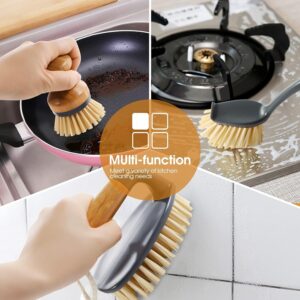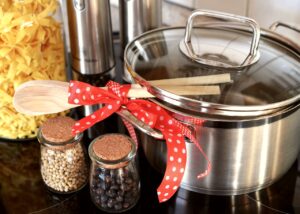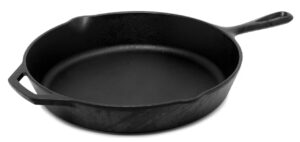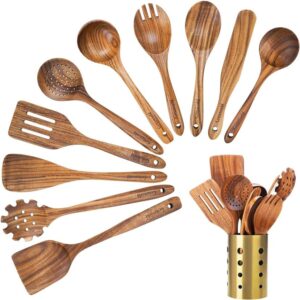Mastering the Art of Sparkling Utensils
As a passionate advocate for all things kitchen-related, I’ve spent years honing my skills and exploring the wonderful  world of kitchenware. I know how much pride we take in our kitchen tools and gadgets. But with great tools comes great responsibility – the responsibility to keep them clean and in tip-top shape. In this guide, I’m going to share some of my most effective kitchenware cleaning tips to help you maintain your culinary arsenal and keep it looking as good as new.
world of kitchenware. I know how much pride we take in our kitchen tools and gadgets. But with great tools comes great responsibility – the responsibility to keep them clean and in tip-top shape. In this guide, I’m going to share some of my most effective kitchenware cleaning tips to help you maintain your culinary arsenal and keep it looking as good as new.
The Importance of a Clean Kitchen
Maintaining a spotless kitchen goes beyond appearances; it’s the cornerstone of a healthy and functional cooking space. Your kitchen’s cleanliness directly impacts the quality and safety of your meals. Imagine savoring a delicious dish that’s free from any off-putting tastes or potential health hazards. A clean kitchen ensures precisely that.
Beyond taste and safety, a cluttered and disorganized kitchen can transform the joy of cooking into a daunting chore. Searching for the right utensils or struggling with grimy surfaces can zap the enthusiasm out of your culinary adventures. It’s like trying to compose a symphony in a chaotic room, where finding the right notes becomes a frustrating ordeal.
But don’t worry; you don’t need to be a cleaning wizard to maintain a pristine kitchen. In the following paragraphs, we’ll explore effective cleaning techniques and practical tips to keep your cooking haven sparkling. From stainless steel pots to wooden utensils, we’ll cover it all, so you can enjoy a clean, safe, and delightful cooking experience every time you step into your kitchen. So, let’s roll up our sleeves and dive into the world of kitchenware cleaning.
The Essential Tools for Kitchenware Cleaning
Now, let’s equip you with the essential tools you’ll need to conquer the art of kitchenware cleaning. Think of these items as your trusty sidekicks on your cleaning adventure:
Dish Soap and Warm Water: Picture them as the dynamic duo, the Batman and Robin of kitchen cleaning. Every great cleaning routine starts with these two. A gentle, eco-friendly dish soap combined with warm water forms the foundation of your cleaning arsenal. Not only does this combo get rid of grease and grime, but it also ensures your kitchenware remains free from harmful chemicals.
Soft Brushes and Sponges: These are your knights in shining armor when it comes to battling stubborn stains and lingering residues. Invest in a set of soft-bristle brushes and non-abrasive sponges. They’re like the gentle giants of kitchen cleaning, helping you scrub away those pesky spots without leaving behind scratches on your cherished kitchenware.
lingering residues. Invest in a set of soft-bristle brushes and non-abrasive sponges. They’re like the gentle giants of kitchen cleaning, helping you scrub away those pesky spots without leaving behind scratches on your cherished kitchenware.
Microfiber Cloths: If there’s a secret weapon in the world of kitchenware cleaning, it’s undoubtedly microfiber cloths. Think of them as your ninja assassins, silently and efficiently picking up dirt and grime. But the magic doesn’t stop there; they also have the power to leave surfaces streak-free, ensuring your kitchenware shines like new.
With these trusty tools in hand, you’re well-prepared to tackle any kitchenware cleaning challenge that comes your way. Whether it’s reviving your stainless steel pots or showing some love to your wooden utensils, these tools will be your allies in the pursuit of a spotless kitchen. So, gear up and let’s dive into the exciting world of effective cleaning methods!
Cleaning Different Types of Kitchenware
Now, let’s dive into the fascinating world of cleaning various types of kitchenware, each with its unique quirks and care requirements.
Stainless Steel Pots and Pans: Stainless steel cookware is the workhorse of most kitchens, cherished for its  durability and resilience. To give your stainless steel pots and pans a spa day, start by soaking them in warm, soapy water. This gentle bath helps to loosen up stubborn residue. Then, armed with a soft brush, give them a gentle scrubbing to bid farewell to any lingering grime. For those tenacious stains that refuse to budge, enlist the help of a trusty paste made from baking soda and water. Scrub, rinse, and watch your stainless steel shine like a beacon of culinary hope.
durability and resilience. To give your stainless steel pots and pans a spa day, start by soaking them in warm, soapy water. This gentle bath helps to loosen up stubborn residue. Then, armed with a soft brush, give them a gentle scrubbing to bid farewell to any lingering grime. For those tenacious stains that refuse to budge, enlist the help of a trusty paste made from baking soda and water. Scrub, rinse, and watch your stainless steel shine like a beacon of culinary hope.
Cast Iron Skillets: Cast iron skillets are like the wise elders of your kitchen, requiring special care and respect. The cardinal rule here is to avoid using soap, as it can strip away the cherished seasoning that gives cast iron its unique flavor-enhancing properties. Instead, employ a brush to vanquish any food remnants, rinse with hot water, and ensure thorough drying to thwart the dreaded rust. To maintain that prized seasoning, apply a whisper-thin layer of oil after each use, nurturing the skillet’s character and longevity.
cardinal rule here is to avoid using soap, as it can strip away the cherished seasoning that gives cast iron its unique flavor-enhancing properties. Instead, employ a brush to vanquish any food remnants, rinse with hot water, and ensure thorough drying to thwart the dreaded rust. To maintain that prized seasoning, apply a whisper-thin layer of oil after each use, nurturing the skillet’s character and longevity.
Nonstick Cookware: Nonstick pans are the kitchen’s superheroes, rescuing your eggs from sticky situations. However, they can be a bit delicate. Treat them kindly by avoiding the use of metal utensils, which can scratch their sensitive surfaces. Instead, employ the gentle touch of a soft sponge and mild dish soap. With this approach, your nonstick cookware will continue to be your trusty sidekick in the battle against stuck-on foods.
Wooden Utensils: Wooden utensils bring a rustic charm to your culinary endeavors, but they require tender loving  care. Begin by giving them a soothing hand wash with mild soap and water. Just like a spa day for your kitchen tools, this ensures they stay pristine. But remember, wooden utensils are like sponges themselves, so don’t let them soak for too long to avoid warping. Treat them with respect, and they’ll add that touch of authenticity to your kitchen creations.
care. Begin by giving them a soothing hand wash with mild soap and water. Just like a spa day for your kitchen tools, this ensures they stay pristine. But remember, wooden utensils are like sponges themselves, so don’t let them soak for too long to avoid warping. Treat them with respect, and they’ll add that touch of authenticity to your kitchen creations.
Armed with these insights, you’re now well-equipped to navigate the diverse landscape of kitchenware cleaning. Each type of kitchenware has its unique personality and demands, but with the right approach, you’ll keep them all in top-notch condition, ready to assist you in your culinary adventures. So, let’s roll up our sleeves and embark on this delightful cleaning journey!
Tips for Maintaining Kitchenware
Maintaining your kitchenware is like giving your trusted allies the care they deserve to stay in peak performance. Here’s your playbook for ensuring these culinary companions stay in tip-top shape:
Avoid the Dishwasher: While the siren song of the dishwasher’s convenience might be tempting, remember that not all kitchenware is cut out for the whirlwind inside. Hand washing, like a gentle massage, is often the better choice. It’s kinder to your tools, prolonging their lifespan and keeping them looking sharp. Plus, it’s an excellent opportunity to bond with your kitchenware, getting to know every nook and cranny.
Dry Thoroughly: After their refreshing bath, ensure your kitchenware is completely dry before tucking them away for their beauty sleep. Moisture is the nemesis that can lead to rust, unsightly discoloration, and even the unwelcome guest of bacterial growth. So, let your kitchenware bask in the warm, dry embrace of air before their next adventure.
Store Properly: Think of storing your kitchenware as arranging precious jewels. To prevent scratches and the dreaded clang of metal meeting metal, consider using drawer dividers or hanging hooks for your pots and pans. Each piece deserves its own cozy nook, protected from the wear and tear of everyday life.
With these tips in your arsenal, you’ll be the guardian of your kitchenware’s well-being, ensuring they serve you faithfully for years to come. It’s not just about cleaning; it’s about extending the lifeline of your trusted kitchen companions, allowing them to shine in every culinary endeavor. So, embrace these practices, and your kitchenware will repay you with unwavering support and gleaming beauty.
Conclusion
In the world of culinary delight, having clean and well-maintained kitchenware is essential. It not only enhances the taste of your dishes but also ensures the longevity of your beloved tools. So, embrace these cleaning tips and maintain your kitchenware with care. Your future self will thank you for it!
I hope these kitchenware cleaning tips and recommendations help you keep your culinary tools in pristine condition. Happy cooking!
Frequently Asked Questions (FAQs)
(Q) How often should I clean my kitchenware? (A)Ideally, you should clean your kitchenware after each use to prevent the buildup of stains and residue. However, some items, like cast iron skillets, may require different care routines.
(Q) Can I use bleach to clean my kitchenware? (A)It’s best to avoid using bleach on kitchenware, as it can be harsh and leave harmful residues. Stick to mild dish soap and warm water for most cleaning tasks.
(Q) What should I do if my stainless steel pans have discolored spots?(A) Discoloration on stainless steel pans can often be removed with a paste of baking soda and water. Gently scrub the affected areas and rinse thoroughly.
(Q) Are there any kitchenware materials I should avoid? (A)While most materials are safe, be cautious with aluminum in acidic dishes, as it can react with certain foods. Also, avoid using metal utensils on nonstick cookware.
(Q) How can I prevent my wooden utensils from getting moldy? (A)To prevent mold growth, make sure to dry wooden utensils thoroughly after washing. Store them in a dry, well-ventilated area to maintain their integrity.

